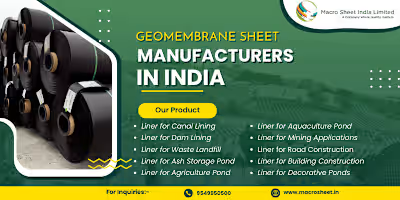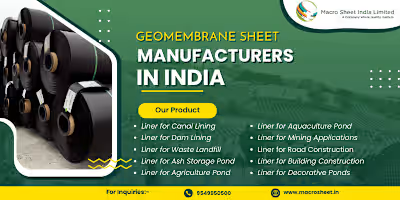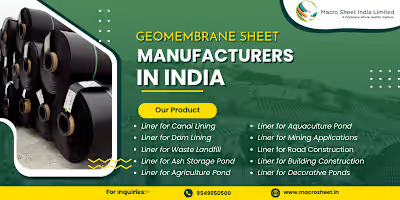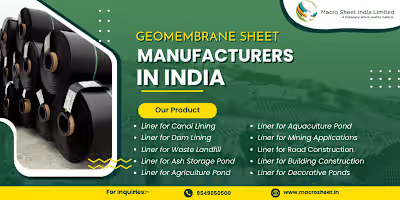Choosing the Right Pond Liner for Agricultural Water Storage
Like this project
Posted Sep 20, 2023
Liner for Agriculture Pond
Likes
0
Views
4
Tags
Agriculture is the lifeblood of many regions, and efficient water management is essential for its success. One crucial element of this management is the use of pond liners to store and conserve water for crops and livestock. The right choice of a pond liner can significantly impact the effectiveness and longevity of your agricultural water storage system. In this blog, we will explore the factors to consider when choosing the right Liner for Agriculture Pond water storage.
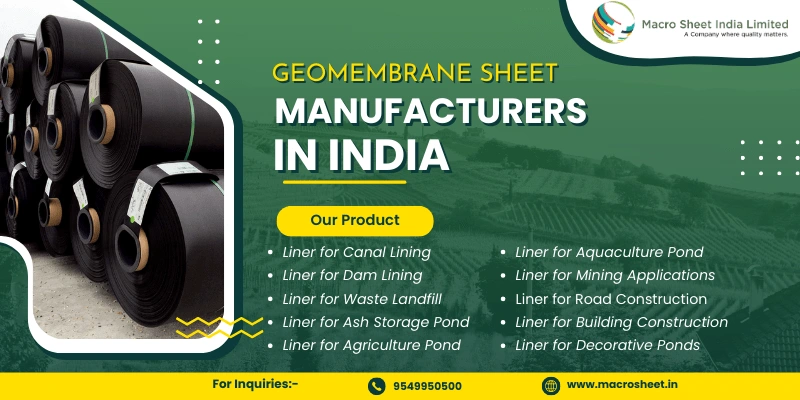
The first and most critical factor in selecting a pond liner is the material. There are several types of Farm Pond Liner materials available, each with its own set of properties and applications:
HDPE (High-Density Polyethylene): Known for its durability and resistance to UV radiation, HDPE liners are an excellent choice for agricultural ponds. They are resistant to punctures, tears, and chemicals, making them suitable for a variety of agricultural applications.
EPDM (Ethylene Propylene Diene Monomer): EPDM liners are flexible and easy to install. They have good resistance to UV rays and are a popular choice for smaller agricultural ponds.
PVC (Polyvinyl Chloride): PVC liners are known for their affordability and ease of installation. However, they may not be as durable as other options, making them suitable for temporary or smaller ponds.
RPE (Reinforced Polyethylene): RPE liners combine the benefits of HDPE and EPDM, offering excellent UV resistance, durability, and flexibility. They are an ideal choice for long-term agricultural water storage.
2. Size and Shape of the Pond
The size and shape of your agricultural pond play a crucial role in determining the type of liner you need. Measure the dimensions of your pond accurately, including its depth, length, and width. The liner should be large enough to cover the entire surface area and provide adequate depth for water storage. Additionally, consider the shape of the pond, as irregular shapes may require custom-cut liners.
3. Environmental Conditions
Assess the environmental conditions in your region before selecting a pond liner. Factors such as temperature extremes, exposure to sunlight, and soil composition can affect the choice of liner material. For example, in areas with intense sunlight, UV-resistant liners like HDPE or RPE may be more suitable to prevent degradation over time.
4. Water Quality and Chemical Resistance
Consider the quality of the water you'll be storing in the pond and any potential chemical exposure. Some agricultural activities may involve the use of chemicals or fertilizers that can interact with the liner. Choose a liner material that offers resistance to these chemicals to prevent damage and contamination of the stored water.
5. Installation and Maintenance
The ease of installation and maintenance should also influence your choice of pond liner. Some liners require specialized installation techniques, while others can be DIY projects. Additionally, consider the long-term maintenance requirements, such as cleaning and repairs, when making your decision.
Use these liners:-
6. Cost and Budget
While cost should not be the sole determining factor, it is an essential consideration. Different pond liner materials come with varying price points. Assess your budget and balance it with the desired qualities of the liner. Keep in mind that investing in a high-quality, durable liner may provide cost savings in the long run through reduced maintenance and replacement costs.
7. Warranty and Manufacturer Reputation
Research the warranties offered by the manufacturer for the chosen pond liner. A solid warranty can provide peace of mind and assurance of the liner's quality. Additionally, consider the reputation of the manufacturer or supplier. Established and reputable companies are more likely to provide reliable products and customer support.
Conclusion
Selecting the right HDPE Pondliner for agricultural water storage is a crucial decision that can impact the efficiency and effectiveness of your farming operations. Consider factors such as material, pond size, environmental conditions, water quality, installation, budget, and warranty when making your choice. Ultimately, a well-chosen pond liner will not only help you conserve and manage water resources effectively but also contribute to the overall success and sustainability of your agricultural endeavors.


